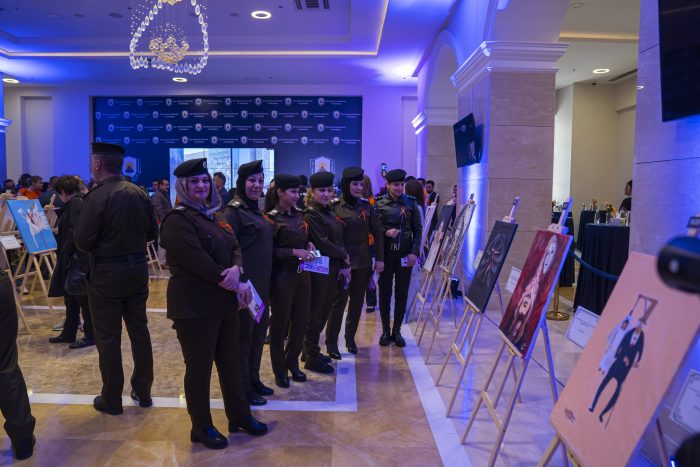Phoenix Art Exhibition at AUK
On November 27, the Student Lounge of the American University of Kurdistan (AUK) was converted into an art gallery for a special exhibition. Assisting AUK in putting on this exhibition were Norwegian Church Aid (NCA) and the Lutheran World Federation (LWF), but the most important contributors to the event were the actual artists. All 60 of the works being displayed were the creations of females recovering from gender-based violence (GBV), and the works were therapeutic. This event, by design, took place during the “16 Days of Activism,” stretching from November 25, the International Day for the Elimination of Violence against Women, to December 10, Human Rights Day.
The event was opened by its hostess, Loreen Hussein Ali, who gave a Kurdish-language overview of the proceedings and would pop back in later to introduce each of the speakers. Her bright orange ribbon and shirt made her blend in, not stand out; dozens of others were wearing the color in adherence to the rallying cry “Orange the World: #United We Stand in Mobilizing Our Resources & Efforts to Address GBV in Iraq.” AUK President Dr. Randall Rhodes delivered the English-language opening remarks, summarizing the university’s efforts to combat “toxic masculinity” and “patriarchal social norms,” by offering 80% of its scholarships to females and prioritizing them for internship placements.

The Iraq Country Director for NCA, Connie Shealy, explicitly connected GBV to other challenges, citing its increase with the pandemic and climate change. She emphasized the urgency of NCA’s work: “GBV is one of the most prevalent human rights violations in the world… Worldwide, 1 in 3 women are experiencing sexual or physical abuse in their lifetime.” The representative for NCA’s partner in this pressing work, Rebecca Duerst of LWF, continued in the same vein: “GBV is a fundamental issue for all of us and needs to be addressed at the societal level.”

The event was titled “Phoenix: Rising from the Ashes of Violence.” The mythological bird of fire would periodically rise from the ashes to live again, and its name is fittingly applied to a gathering celebrating females who have persevered through torment and not wilted despite trauma. Through the caring intervention of others, these valiant women underwent art therapy, soothing their souls until their figurative rebirths.

The paintings represented an eclectic mix of styles, and in their snaking around the Student Lounge the 60 artworks showed an impressive range of colors, images, and themes. It would not be possible to make a general statement adequately describing the content of all the works; the medium of painting and the experiences as GBV victims are the unifying threads.
Despite the variety, there were some concepts recurring across multiple paintings. Wings – on birds, on angels, on a butterfly – appeared regularly. Other common inclusions were symbols of GBV (battered bodies, raised fists); imprisonment (chains, cages); war (weapons, blood); manipulation (puppetry, tearing away from school and into matrimony); shame (facepalming, public ridicule); voicelessness and sightlessness (hands over the mouth, covers over the eyes); and injustice (scales, imbalanced). Each of the paintings had a title, and several of them alluded to a triumph over “darkness”: e.g., “A Woman Is like a White Rose, Blooms despite the Darkness Surrounding It” and “Even after Experiencing a Lot of Darkness, One May Still Become Something Beautiful.” Therein lies a potent message, for us all.



